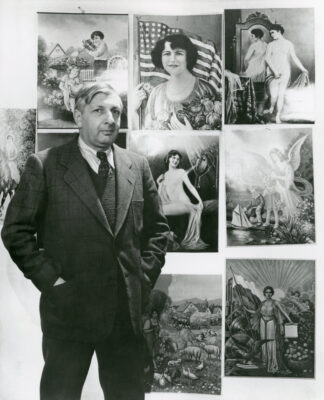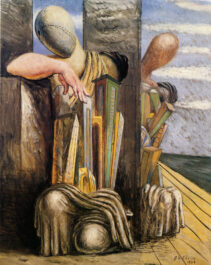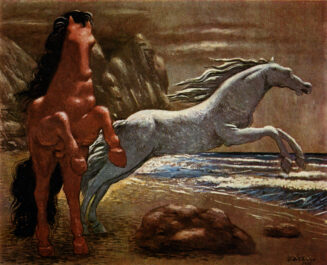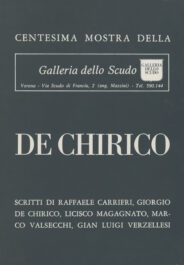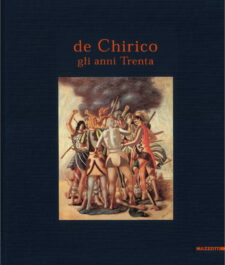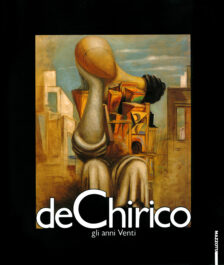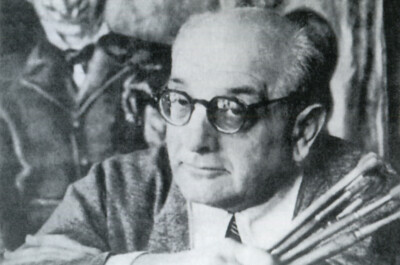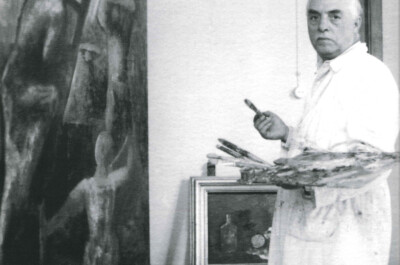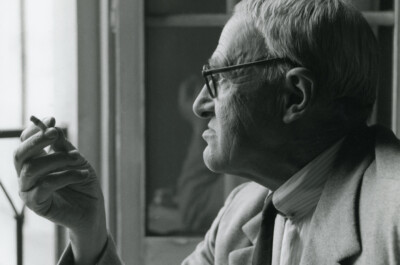Giorgio de Chirico was born in Volos, the capital of Thessaly, in 1888. His parents were Evaristo de Chirico, an railway engineer and descendent of a Sicilian family that had moved to Tuscany, and Gemma Cervetto, a Genoese noblewoman. After the death of his father, in 1906 the de Chirico family moved to Munich. Giorgio de Chirico began to study at the fine arts academy and also closely studied the work by Böcklin and Klinger, above all, in the museums. He became interested in philosophy and studied Nietzsche, Schopenhauer, and Weininger. It was in this period that he painted his first works inspired by Böcklin.
He returned to Rome in 1910 and in the following year he and his mother decided to join his brother in Paris where he was involved with concerts of music. But before reaching Paris, they stopped at Florence and Turin where de Chirico was deeply impressed by the deserted piazzas of the city and its monumental architecture immersed in the warm summer light, which inspired the works of the metaphysical period: Enigma dell’oracolo and Enigma di un pomeriggio di autunno, exhibited for the first time at the Salon d’Automne in Paris in 1912. In 1913 he exhibited at the Salon des Indépendents and became close to the artists of the Cubist avant-garde, and thanks the critic Apollinaire, he signed a contract with the young dealer Paul Guillaume. It was thanks to his international contacts that the name of the de Chirico brothers became known in America as early as 1914.
With the outbreak of war both went back to Italy and enlisted. In Ferrara they met Filippo de Pisis and Carlo Carrà who, with his recuperation of a neo-primitivism figuration after having abandoned his Futurist painting in 1916, was receptive to de Chirico’s influence. This was the beginning of what was to become known as “Metaphysical painting”, a phrase that indicated an approach that, by going beyond the boundaries of objective reality revealed unusual and deeper aspects of things. In the meantime, Giorgio de Chirico had made contacts with Tzara, the founder of the Dada movement in Zurich. Having returned to Rome in 1918, he began to take part in the art life of the capital by collaborating with the Valori Plastici group. In 1919 he exhibited at Anton Giulio Bragaglia’s Casa d’Arte; for this occasion he flanked his work with his fundamental essay Noi Metafisici. The show was a flop; in “Il Tempo” the critic Roberto Longhi slated the show in a sarcastic article titled Il dio ortopedico (The Orthopaedic God). He collaborated with the Valori Plastici group, taking part in shows of the same name in Germany (Berlin and Hamburg, 1921); these led to the establishment in Europe of Magic Realism. He then took part in the Fiorentina Primaverile in 1922 in Florence.
In the meantime, already in 1919 there can be felt in Giorgio de Chirico’s language a return to antique painting, something that went hand in hand with his rethinking about painting technique. He continued to live in Rome and Florence, the guest of the critic and collector Giorgio Castelfranco, and in 1923 he exhibited at the second Rome Biennale an Autoritratto con busto di Mercurio, together with some “Roman villas” which showed further inspiration by Böcklin; these works were favourably welcomed by the critics. In 1924, after having married the Russian dancer and archaeologist Raissa Gurievich Krol, he exhibited for the first time at the Venice Biennale, and that autumn in Paris he designed the scenes and costumes for the ballet La giara, inspired by Pirandello.
He became friends with the Surrealists and collaborated with Breton’s magazine “La Revolution Surréaliste”. In 1925 he moved to Paris where he was to remain until 1931. His works were included in the first Surrealist show at the Galerie Pierre, while a solo show of recent works was organised at the Galerie Rosenberg in Paris. But already at the end of the same year there was sharpened his polemic with the Surrealists who bitterly criticised his recent work, the work that followed his Metaphysical period and that was considered to be anti-modernist. In this period there appeared some themes that were to be widely developed in the following years: archaeology, manikins, horses by the seashore, furniture in a valley, landscapes in a room, and gladiators.
Present at the first exhibition of the Novecento italiano in Milan (1926), and throughout the 1920s and 1930s he held numerous solo shows in Italy and abroad. In 1928 there were published the monograph by Waldemar George, and the “indirect study essay” about de Chirico by Jean Cocteau, Le Mystère Laïc. In 1929 Giorgio de Chirico published his autobiographical “novel” Hebdomeros and he exhibited in almost all the shows of the “Group des Italiens de Paris”. In the same year the Parisian publishing house Gallimard published Apollinaire’s Calligrammes, with sixty-six lithographs by de Chirico. For Diaghilev’s Russian ballet company he designed, in 1930, the sets and costumes for the ballet Le Bal. During the last year of his time in Paris he met Isabella Far, a Russian who was to become his second wife.
In 1932, the year he returned to Italy and the beginning of a prolific period as a set designer, he took part in the Venice Biennale and the fifth Milan Triennale; settling in Florence. From this period is the cycle of "Mysterious Baths". In 1936 he went to New York, where he remained for three years, exhibiting in some American cities. In 1936 his participation in the first International Surrealist Exhibition in London and the show Fantastic Art, Dada, Surrealism held in the New York Museum of Modern Art were of great significance. Having returned to Italy in 1938, he settled in Milan. Then he began to work on some terracotta sculptures which repeated some of the favourite themes of his paintings.
With the beginning of the next decade de Chirico began his baroque period with self-portraits in costume, and with a return to the great masters of the sixteenth and seventeenth centuries. In 1944 he moved definitively to Rome. Among the main group shows he took part in, mention should be made of the Venice Biennale (1942, 1948, 1956, 1972), the Rome Quadriennale (1943, 1951, 1955, 1959, 1965, 1972), and Documenta I in Kassel (1955). In 1949, 1952, and 1954 he organised, respectively in London and Venice, solo exhibitions in protest against the acceptance only of his Metaphysical period by a section of critics, and also against the criterion for selecting mostly abstract works for the Venice Biennale. Following 1970, when a vast retrospective show of his work had been organised in Milan, various shows by Giorgio de Chirico were held in Italy; he was also awarded important honours, above all abroad. He died in Rome in 1978.
